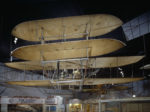One half of the Wright Brothers sets a new record, a new agency is formed to explore other worlds and a communications giant is born… It all happened This Week in Tech History.
This week in 1909 – Orville Wright (one of the famous Wright Brothers, along with Wilbur) set a record for the longest airplane flight. Orville was testing the Army’s first airplane and kept it aloft for 1 hour, 12 minutes and 40 seconds over Fort Myer, Virginia. He was so tired from the experience that he crash-landed the plane.
1925 – Station 2XAG in Schenectady, NY became the first radio station in the U.S. to broadcast with a 50,000-watt transmitter. The station, soon known as WGY Radio, could broadcast with 50,000 watts, since it was owned by the General Electric Company — a company that knew lots about watts. Today, WGY still broadcasts with its original call letters and is still using 50,000 watts of power.
1958 – President Dwight Eisenhower signed the National Aeronautics and Space Act, establishing the National Aeronautics and Space Administration, or NASA. When it began operation in October of that year, NASA absorbed and replaced the National Advisory Committee for Aeronautics which was formed in 1918 to undertake, promote, and institutionalize aeronautical research. The formation of NASA was the US’s response to the Soviet Union’s launch of Sputnik 1, the world’s first artificial satellite the previous year.
1998 – Bell Atlantic Corp. and GTE Corp. announced a $52.88 billion stock-swap deal to create the second-biggest telephone company — behind AT&T. The resulting mega-corporation — later to be named Verizon Communications — would begin with 63 million local telephone lines in 38 states and revenue of $53 billion.
And this week in 2008 – The Federal Communications Commission approved the merger of Sirius Satellite Radio and rival XM. Many thought the merger would never be approved given that Sirius and XM were the only satellite radio providers, and that the merger would create a monopoly. That thought was dismissed earlier that year when The U.S. Justice Department approved the merger, concluding that satellite radio competes with terrestrial radio, online streaming, and mp3 players.






